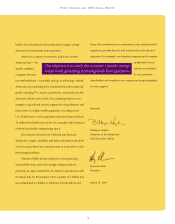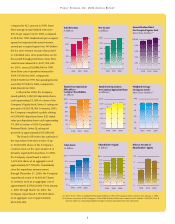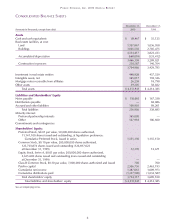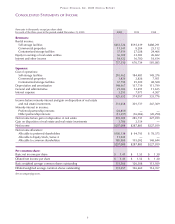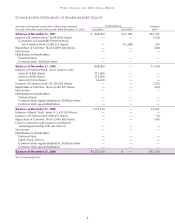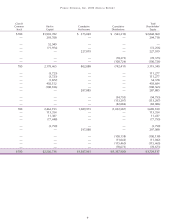Public Storage 2000 Annual Report Download - page 15
Download and view the complete annual report
Please find page 15 of the 2000 Public Storage annual report below. You can navigate through the pages in the report by either clicking on the pages listed below, or by using the keyword search tool below to find specific information within the annual report.
13
P
UBLIC
S
TORAGE
, I
NC
. 2000 A
NNUAL
R
EPORT
For purposes of financial statement presentation, we consider all highly liquid debt instruments purchased with a maturity of three
months or less to be cash equivalents.
Due to the short period to maturity of our cash and cash equivalents, accounts receivable, other assets, and accrued and other
liabilities, the carrying values as presented on the consolidated balance sheets are reasonable estimates of fair value. The carrying
amount of mortgage notes receivable approximates fair value because the aggregate mortgage notes receivable’s applicable interest
rates approximate market rates for these loans. A comparison of the carrying amount of notes payable to our estimated fair value is
included in Note 7, “Notes Payable.”
Financial assets that are exposed to credit risk consist primarily of cash and cash equivalents, accounts receivable, and notes
receivable. Cash and cash equivalents, which consist of short-term investments, including commercial paper, are only invested in
entities with an investment grade rating. Notes receivable are substantially all secured by real estate facilities that we believe are
valued in excess of the related note receivable. Accounts receivable are not a significant portion of total assets and are comprised of
a large number of individual customers.
Real estate facilities
Real estate facilities are recorded at cost. Depreciation is computed using the straight-line method over the estimated useful lives of the
buildings and improvements, which are generally between 5 and 25 years.
Evaluation of asset impairment
In 1995, the Financial Accounting Standards Board issued Statement No. 121, “Accounting for the Impairment of Long-Lived Assets
and for Long-Lived Asset to be Disposed Of” which requires impairment losses to be recorded on long-lived assets. We annually
evaluate long-lived assets (including goodwill), by identifying indicators of impairment and by comparing the sum of the estimated
undiscounted future cash flows for each asset to the asset’s carrying amount. When indicators of impairment are present and the sum
of the undiscounted cash flows is less than the carrying value of such asset, an impairment loss is recorded equal to the difference
between the asset’s current carrying value and its value based upon discounting its estimated future cash flows. Statement No. 121 also
addresses the accounting for long-lived assets that are expected to be disposed of. Such assets are to be reported at the lower of their
carrying amount or fair value, less cost to sell. Our evaluations have indicated no impairment in the carrying amount of our assets.
Other assets
Other assets primarily consist of furniture, fixtures, equipment, and other such assets associated with the containerized storage
business as well as accounts receivable, prepaid expenses, and other such assets of the Company. Included in other assets with respect
to the containerized storage business is furniture, fixtures, and equipment (net of accumulated depreciation) of $28,544,000 and
$34,704,000 at December 31, 2000 and 1999, respectively. Included in depreciation and amortization expense is $4,801,000,
$4,915,000, and $4,317,000 in the years ended December 31, 2000, 1999 and 1998, respectively, of depreciation of furniture,
fixtures, and equipment of the containerized storage business.
Intangible assets
Intangible assets consist of property management contracts ($165,000,000) and the cost over the fair value of net tangible and
identifiable intangible assets ($67,726,000) acquired. Intangible assets are amortized straight-line over 25 years. At December 31,
2000 and 1999, intangible assets are net of accumulated amortization of $47,709,000 and $38,400,000, respectively. Included in
depreciation and amortization expense is $9,309,000 in each of the three fiscal years ended December 31, 2000 with respect to
the amortization of intangible assets.
Revenue and expense recognition
Property rents are recognized as earned. Equity in earnings of real estate entities are recognized based on our ownership interest in the
earnings of each of the unconsolidated real estate entities. Advertising costs of $11,987,000, $10,160,000 and $14,332,000 for 2000,
1999 and 1998, respectively, were expensed as incurred.


